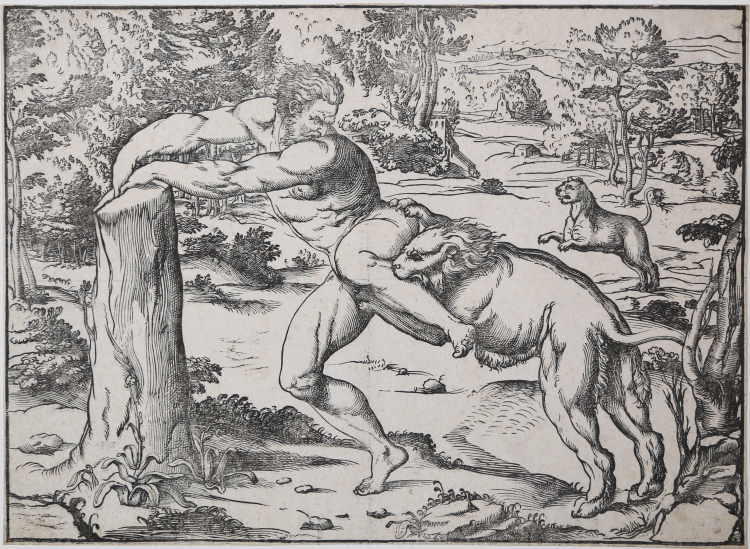




| Reference: | S45917 |
| Author | Niccolò BOLDRINI |
| Year: | 1560 ca. |
| Measures: | 420 x 305 mm |



| Reference: | S45917 |
| Author | Niccolò BOLDRINI |
| Year: | 1560 ca. |
| Measures: | 420 x 305 mm |
Milo of Croton with his hands imprisoned in a tree while being attacked by a lion.
Woodcut, c. 1560, unsigned and without printing details. After a subject by Giovanni Antonio da Pordenone.
Beautiful proof, printed on contemporary laid paper without watermark, with small margins beyond the line of demarcation, traces of central vertical fold, minimal oxidation, otherwise in excellent condition.
The great 6th-century B.C.E. athlete Milo da Crotone, about whom Diodorus Siculus tells us, is surprised by a pack of ferocious beasts while he is stuck with one hand in a tree from which he cannot extricate himself. One of these - a wolf in historical sources, a lion in woodcuts - bites him in the calf and kills him.
Naoko Takahatake attributes the woodcut, due to obvious stylistic similarities and based on examination of the watermarks found, to Niccolò Boldrini. A chiaroscuro version of the work is also known through the only example known today, printed with greenish and black color from two blocks, preserved in the British Museum. Pierre Mariette, describing this one block woodcut and not knowing the chiaroscuro version, realized that 'the drawing in black seemed incomplete, as if it needed the tonal block' (Muraro Rosand 1976, p. 138). As in the case of the Galloping Horseman, Milo of Crotone was not the result of a direct collaboration between Boldrini and Pordenone: the carver had to copy, many years after Pordenone's death, an invention of his own (Landau 1983, p. 345).
Milo of Crotone was painted by Pordenone in the frescoes - now completely lost - of the Mantica palace in Pordenone. In the collection of the Smart University of Chicago (inv. 1975.31) there is a painting by Pordenone with the same subject, but with a neutral landscape. Boldrini probably associated Pordenone's invention with a different landscape (Landau 1983, p. 345).
http://smartcollection.uchicago.edu/objects/3120/milo-of-croton-attacked-by-wild-beasts
If there is only one known example of the chiaroscuro, the woodcut is also extremely rare; Naoko Takahatake describes only these 7 examples: British Museum, London [1858,0417.1578], Museum of Fine Arts, Boston [1975.497], Museum of Fine Arts, Boston [P19578], Metropolitan Museum of Art, New York [49.51.2] Bassano del Grappa, Museo Civico, [n. inv. III-73-127], Smart Museum of Art, University of Chicago [1977.109], Brema Kunsthalle [inv. 33093].
Bibliografia
Passavant J.D., Le peintre-graveur: contenant l'Histoire de la gravure sur bois, sur métal et au burin jusque vers la fin du XVI siècle [...], Paris, 1860-1864, v. VI, p. 237, n.70; Tiziano e la silografia veneziana del Cinquecento, Vicenza, 1976, pp. 138-139, n. 81; Landau D., Printmaking in Venice and the Veneto, in “The Genius of Venice, 1500-1600”, London, 1983, p. 345; Urbini S., Atlante delle xilografie italiane del Rinascimento, ALU.0288.1; Naoko Takahatake, 'The chiaroscuro woodcut in Renaisssance Italy', Los Angeles 2018, pp. 205-14.
Niccolò BOLDRINI (Vicenza, 1500 circa; Venezia, 1530–70)
|
Italian wood-engraver. He is known only by his signed prints drawn from the designs of various artists. The inscription TITIANVS INV/Nicolaus Boldrinus/Vicenti[n]us inci/debat. 1566 on the chiaroscuro woodcut of Venus and Cupid testifies to its derivation from a Titian model as well as to its date. Boldrini was long considered the engraver of Titian’s work par excellence and his direct collaborator, but today critical opinion (Oberhuber) tends to see such collaboration only in the famous woodcut of the Six Saints. Stylistic and historical considerations lead to the conclusion that some landscape prints, such as Landscape with a Milkmaid and St Jerome in the Wilderness, are not the product of a direct relationship between Boldrini and Titian but rather the work of the German Giovanni Britto. Of around 30 works of very different style and engraving quality that have been assigned to Nicolò Boldrini, among the most famous, also known in chiaroscuro forms, are the Caricature of Laokoon and Marco Curzio by Pordenone.
|
Niccolò BOLDRINI (Vicenza, 1500 circa; Venezia, 1530–70)
|
Italian wood-engraver. He is known only by his signed prints drawn from the designs of various artists. The inscription TITIANVS INV/Nicolaus Boldrinus/Vicenti[n]us inci/debat. 1566 on the chiaroscuro woodcut of Venus and Cupid testifies to its derivation from a Titian model as well as to its date. Boldrini was long considered the engraver of Titian’s work par excellence and his direct collaborator, but today critical opinion (Oberhuber) tends to see such collaboration only in the famous woodcut of the Six Saints. Stylistic and historical considerations lead to the conclusion that some landscape prints, such as Landscape with a Milkmaid and St Jerome in the Wilderness, are not the product of a direct relationship between Boldrini and Titian but rather the work of the German Giovanni Britto. Of around 30 works of very different style and engraving quality that have been assigned to Nicolò Boldrini, among the most famous, also known in chiaroscuro forms, are the Caricature of Laokoon and Marco Curzio by Pordenone.
|